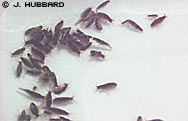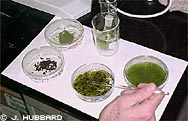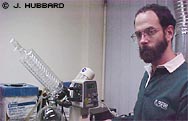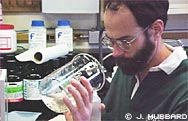April 24, 2000
Chuck AmslerIn my last journal entry (Bioassays: Prologue) I discussed the general idea of bioassays. I also described one of our collecting trips to collect the bioassay species I spend much of my bioassay time with: amphipods.
As I mentioned in that last post, amphipods are tiny marine animals that are related to but much smaller than shrimp. They are important consumers in marine environments around the world and have many similarities to insects on land in the roles they play both as predators and as prey. The species we work with is an omnivore that we commonly find living on and (apparently) consuming macroalgae in the ocean. We collect them from algal beds in shallow tide pools because that is the easiest way for us to catch them but we see them often during dives. In the lab we keep the animals in special plastic jars I call "Andy Bottles" because Andy constructed a number of them for the group. They are 2 and 4 liter, wide mouth plastic bottles that have one or two large "windows" cut into them. Andy attached window screening over the windows that keeps the animals in but allows water exchange so that there is no oxygen depletion.
Most of the amphipod assays are being run with extracts rather than intact plant material. Bruce prepares the extracts by soaking the plants in two successive combinations of organic solvents over a number of days. The first solvent mix extracts those compounds that are more soluble in lipids while the second gets those compounds that are more soluble in things like water.
The extracts are dried to remove the solvents, which can take a couple hours to a day. That allows us to determine how much of each was in the macroalgae to begin with and then we add that same relative amount to disks of artificial food. The food we use is dried green algae within a gel-like matrix of a material called alginate. Alginate is a compound extracted from giant kelp, which are brown macroalgae that grow in California and elsewhere. It is commonly used in processed foods that people eat, too.
Preparation for a bioassay begins the day before it is actually run. On the day before an assay, I re-dissolve the extract in solvents and then add dried green algal powder. Then I evaporate the solvents off in a device called a rotary evaporator (rotovap).
This rotates the mixture under a vacuum while warming it just barely above room temperature. The rotovap allows the solvents to evaporate quick enough to make working with them practical without us having to risk changing the chemistry of the compounds by heating them.
The extract-coated algal powder is placed into a plastic dish and liquid alginate is added. Then I use a glass rod to stir the powder into the alginate. I also make a "control" mixture. The control has the dried algal powder and the same added solvents as the extract, but no extract. A few drops of red food coloring are added to either the control or extract alginate so that we can tell them apart later (we already know that the animals don't care if their food is green or red).
Finally, a solution of calcium salt is poured over the liquid alginate. That causes the alginate to form a gel that is a bit firmer than the Jello people eat. Right before the assay begins, this is cut into 1 centimeter diameter disks for use in the assays.
The bioassays normally run for 12 hours. I usually set mine up early in the morning. The first thing I do is count out 200 amphipods in batches of five and divide them into 10 different 250 ml plastic bottles, each bottle matched with an amphipod-free plastic bottle. That is a total of 20 bottles.
I carefully weigh one control disk and one extract disk to be put in each bottle. That means that each amphipod has a choice to eat the extract or the control. Then, the bottles go into an aquarium with flowing seawater around them to keep them at natural temperatures throughout the assay.
At the end of the assay I pour the contents of each bottle into a 1 liter beaker and fish out the disks. I weigh each one again. Then I can tell if the amphipods preferred the control or the extract disks better by which one lost the most weight. The bottles without amphipods tell me how much the weight of the disks would have changed if no amphipods were present. If the animals ate significantly less of the extract than of the controls, that suggests that the macroalgae that the extracts were prepared from could have been chemically defended from amphipod herbivory. It does not prove that is so but is one very important part of the process of understanding the role of chemical defenses.
|





